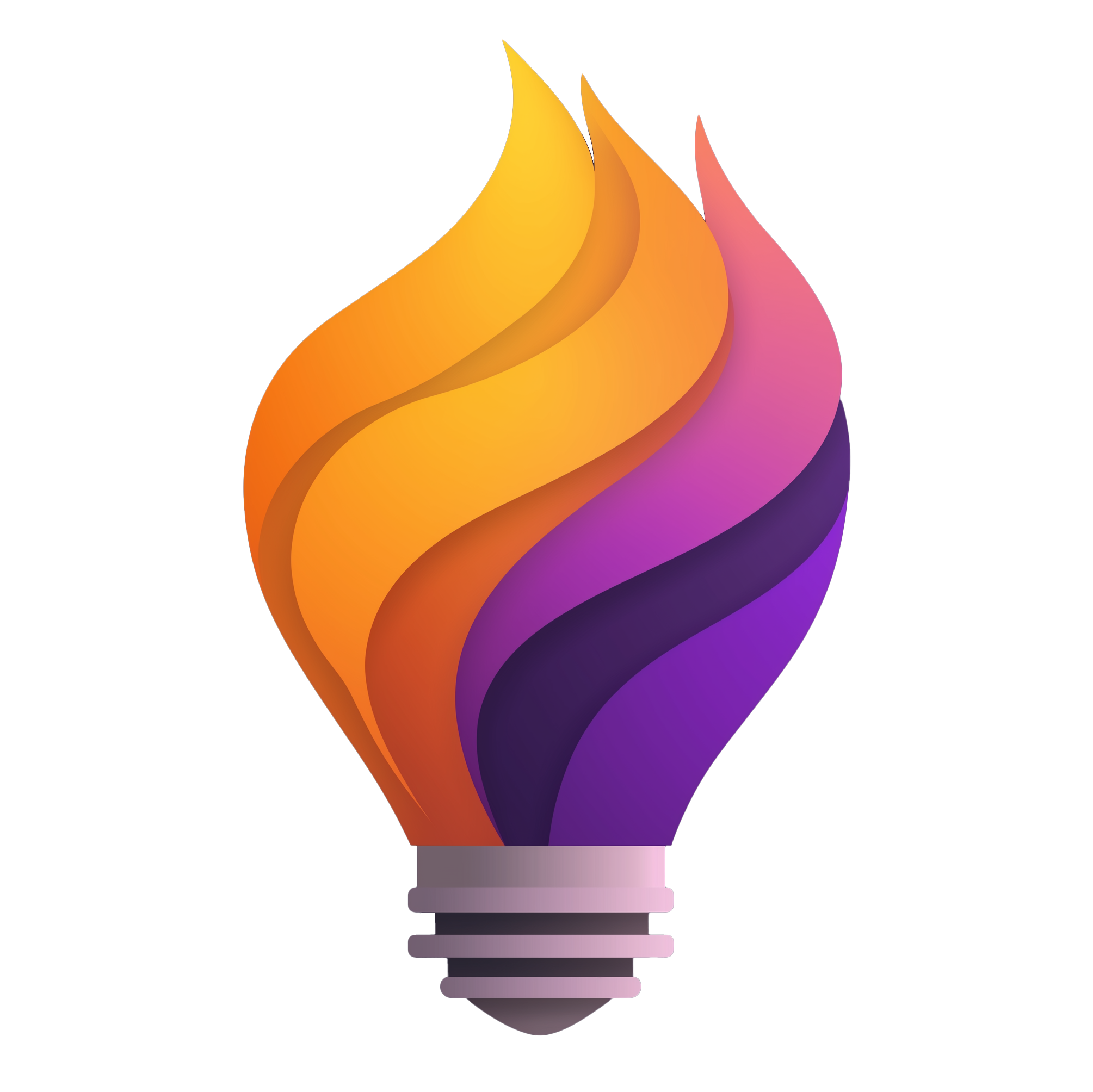Let’s be honest: a workshop without a clear goal is just a meeting in disguise. It's that long, expensive calendar block that could have easily been an email. If you want to plan workshops that actually create value, the real work happens long before anyone logs on or walks into the room. It all boils down to defining one single, measurable outcome and getting the right people involved to make it happen.
Laying the Groundwork for a Great Workshop
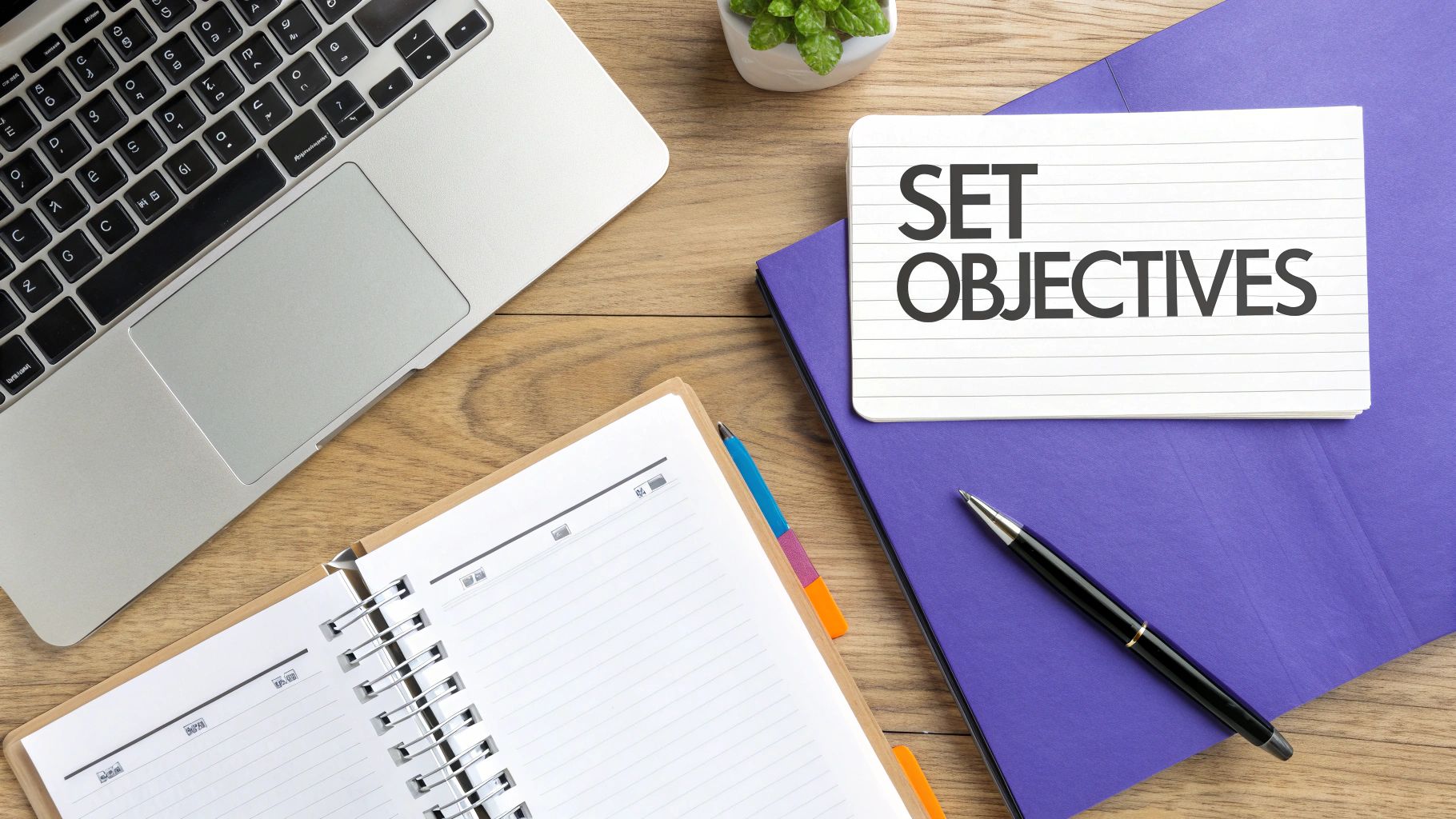
The magic of a truly productive workshop starts with a few simple but powerful questions. What specific, tangible thing must we have in our hands when this session is over? Who absolutely has to be part of this conversation? Answering these honestly builds the foundation for every other decision you'll make, from the agenda to the snacks.
This isn't just about logistics. It's about engineering an environment for real progress. This upfront thinking is what turns your workshop from another hour of talk into a genuine catalyst for action.
Define Your Primary Objective
Before you even dream of sticky notes or breakout rooms, you need to lock down your workshop's "north star." This is a single, clear, and actionable goal that everyone can rally around. Vague aims like "discuss the new marketing strategy" are a recipe for conversations that go nowhere.
Instead, frame your objective around a concrete deliverable.
- Weak Objective: Discuss Q3 marketing ideas.
- Strong Objective: Generate and prioritize three campaign concepts for the Q3 product launch, with an assigned owner for each.
See the difference? A specific goal immediately gives the session focus and a clear finish line. It turns a brainstorming session into a decision-making engine. For a more comprehensive look at the entire process, a good event planning blueprint can help you structure every stage.
Identify and Analyze Your Stakeholders
With your objective set, the next question is: who needs to be in the room? A classic mistake is inviting either too many people (which grinds decision-making to a halt) or too few (which means you'll lack buy-in down the road).
A quick stakeholder analysis will save you a lot of headaches. For the objective you just defined, make a list of:
- Decision-Makers: Who has the final authority to approve the outcome?
- Key Contributors: Who has the essential knowledge or expertise to get the work done?
- Impacted Parties: Whose day-to-day work will change based on the decisions made?
A well-curated attendee list is critical. You need a group diverse enough to generate robust ideas but small enough to remain nimble and make concrete decisions. Aim for a group of 8-15 participants for optimal engagement.
This is more than just an invite list; it’s about understanding what makes each person tick. What does the head of engineering need out of this session compared to the lead product designer? Knowing their individual motivations helps you frame the workshop in a way that gets everyone invested from the start. If your goal is to spark creative problem-solving, our design thinking workshop template has some great structured ideas for you. You can find it right here: https://www.remotesparks.com/design-thinking-workshop-template/
Designing an Agenda That Keeps People Engaged
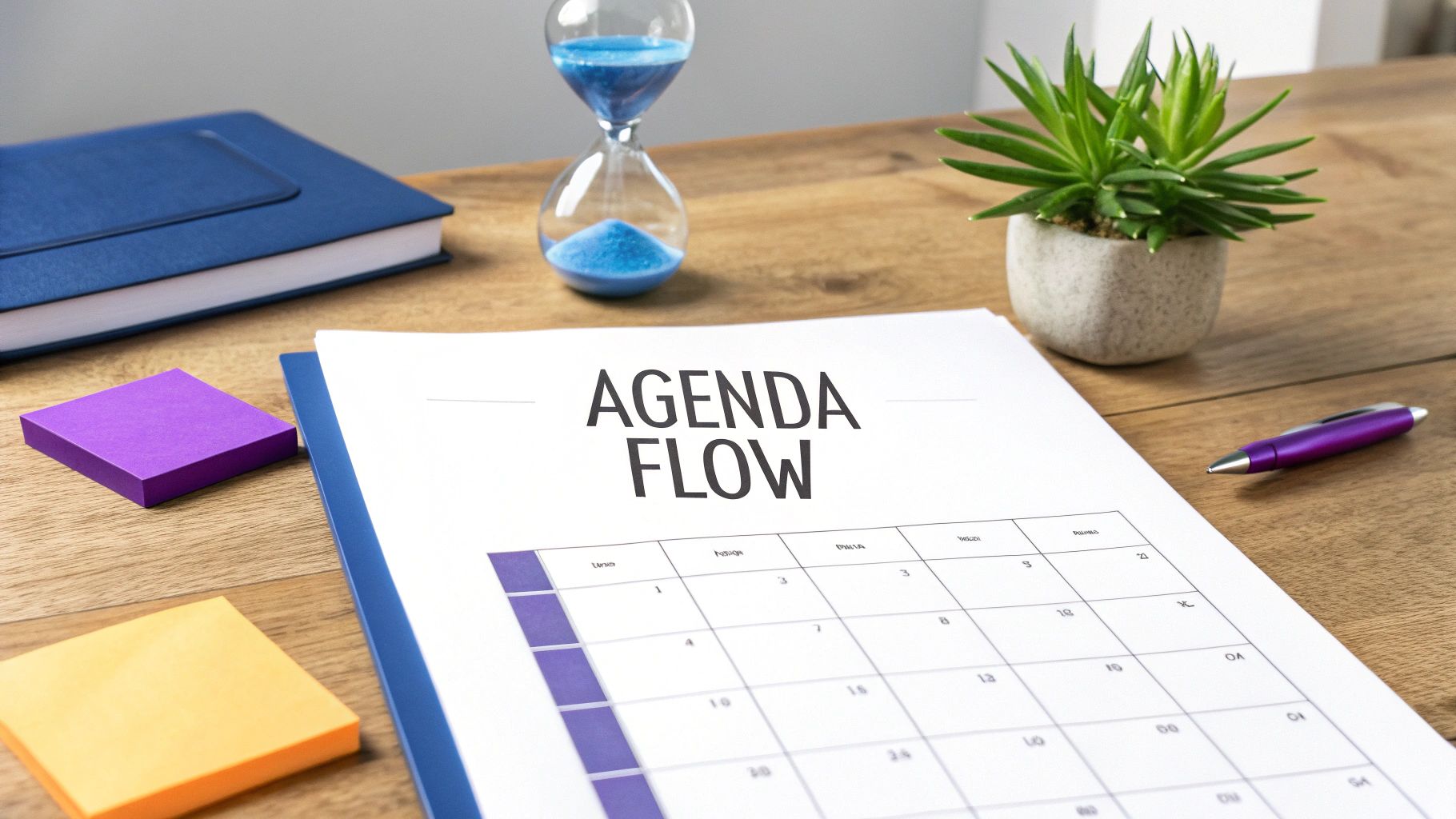
A truly effective agenda is more than just a schedule—it’s the narrative of your workshop. It’s what transforms a simple meeting into a productive, collaborative experience by guiding participants from an initial problem to a set of clear, actionable solutions.
Think of it this way: a great agenda has a rhythm. It should feel intentional, balancing intense, focused work with moments for reflection and connection. Without that carefully planned flow, even the best-laid plans can get derailed by unfocused chatter or awkward silences.
Embrace the Diverge and Converge Model
One of the most powerful frameworks I've ever used for agenda design is the "diamond" model. It’s built on a simple, two-part cadence that mimics natural creative problem-solving: first, you diverge to explore every possibility, then you converge to make a concrete decision.
Divergence is all about going wide. This is the "no bad ideas" phase where the goal is to generate a ton of raw material without judgment. You’ll use activities like brainstorming, mind mapping, or round-robin discussions to get all the creative juices flowing and hear from everyone in the room. The focus here is pure quantity and exploration.
Next up is convergence. This is where you switch gears and start narrowing things down. The group shifts from generating ideas to evaluating them. Activities like dot-voting, sorting ideas into themes (affinity mapping), or using a prioritization matrix help the team analyze everything and commit to a clear path forward.
A well-designed agenda often features multiple diamonds. You might diverge to explore the root cause of a problem, converge on a specific problem statement, then diverge again to brainstorm solutions before finally converging on the top three ideas to pursue. This rhythm is what keeps a session dynamic and productive.
Structuring your workshop around this model is a game-changer. It prevents the all-too-common mistake of trying to generate and critique ideas at the same time, which is a surefire way to kill creativity before it even starts.
Building Your Agenda Block by Block
Once you've got the diverge-and-converge flow in mind, you can start slotting in the specific activities. Each activity is a building block, designed to achieve a small outcome that moves the group one step closer to the main goal.
A smart agenda isn’t just a to-do list; it’s a schedule built for human beings.
- The Warm-Up (10-15 mins): Kick things off with a quick icebreaker. This isn't just about being friendly—it gets people talking, sets a collaborative tone, and helps everyone mentally "arrive" at the workshop.
- The Core Activities (60-90 mins): This is the heart of your session. It's where you'll run your main divergent and convergent exercises. I find it’s best to break this chunk into smaller, time-boxed activities to keep the energy high.
- The Strategic Break (10-15 mins): Never, ever skip the break. It’s critical for fighting off screen fatigue and letting new ideas sink in. As a rule of thumb, plan for a break every 75-90 minutes in longer workshops.
- The Wrap-Up (15-20 mins): Don't just let the session fizzle out. End strong by summarizing the key decisions and outlining exactly what happens next. The best time to assign owners and deadlines is right then and there, while the momentum is still high.
This structure is a reliable starting point. For more detailed layouts, checking out a simple meeting agenda template can give you some great ideas to adapt for your specific needs.
To give you a better sense of how this looks in practice, here is a sample structure for a 3-hour session.
Sample Workshop Agenda Structure (3-Hour Session)
This template shows how you can balance different activity types to maintain engagement and hit your goals within a tight timeframe.
| Time Allotment | Activity Type | Purpose & Goal |
|---|---|---|
| First 15 mins | Icebreaker & Welcome | Set a positive tone, introduce the objective, and get everyone comfortable. |
| Next 45 mins | Diverge: Brainstorming | Generate a wide range of ideas on the core problem without judgment. |
| Next 30 mins | Converge: Dot-Voting | Quickly identify the top 3-5 ideas the group wants to explore further. |
| Next 15 mins | Bio Break | Allow participants to recharge, grab a coffee, and step away from the screen. |
| Next 45 mins | Diverge: Solution Jam | Deep-dive on the top ideas, brainstorming concrete ways to implement them. |
| Next 20 mins | Converge: Action Plan | Define clear, actionable next steps, assigning owners and deadlines for each. |
| Final 10 mins | Wrap-Up & Feedback | Summarize achievements, thank participants, and gather quick feedback. |
This structure ensures you're not just talking, but actively moving toward a tangible outcome.
Mastering Time-Boxing and Flow
When you're putting your agenda together, time-boxing is your secret weapon. By assigning a strict time limit to each activity, you create a healthy sense of urgency that keeps everyone focused and prevents conversations from wandering off into the weeds.
Be realistic with your timing, but also firm. A brainstorming session might get 15 minutes, while a more complex decision-making exercise might need 25 minutes.
Finally, always think about the emotional journey of your participants. Start with easier, low-pressure activities to build psychological safety before you dive into more challenging or controversial topics. A thoughtfully sequenced agenda creates an environment where people feel comfortable contributing, staying focused, and doing their best work from start to finish.
Choosing Activities and Tools That Spark Action
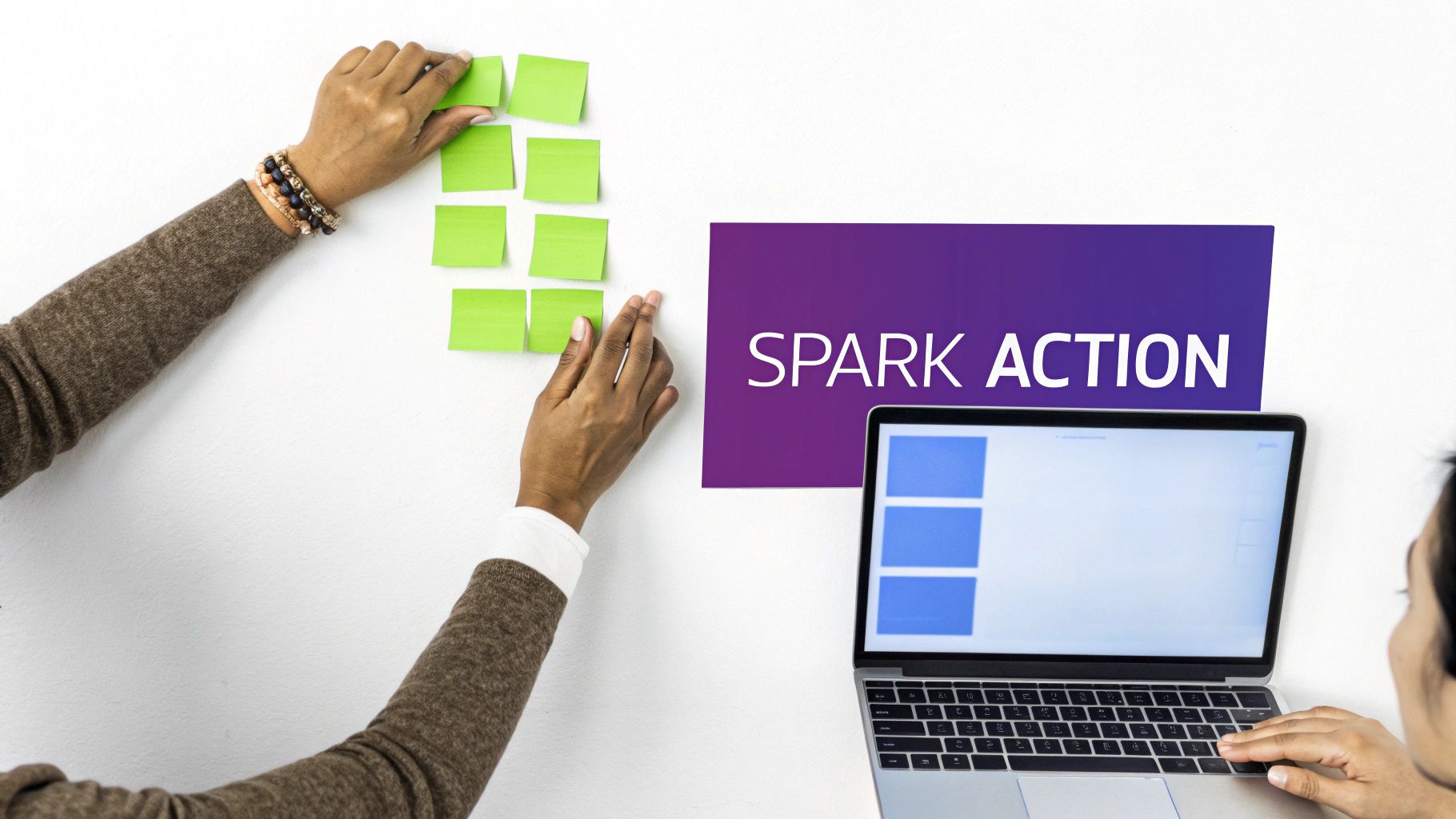
Once your agenda is locked in, the real fun begins: picking the activities. This is where the magic happens. The exercises you choose are the engines that will turn your workshop from a passive presentation into an active, collaborative session.
Think of it this way: you wouldn't use a hammer to turn a screw. The right exercise doesn't just fill time; it creates energy, opens up new ways of thinking, and keeps everyone moving toward the goal you set out to achieve.
A Toolbox of Proven Workshop Exercises
Every great facilitator has a go-to list of activities they can pull from. Building your own toolbox gives you the confidence to adapt on the fly, whether you need to boost low energy or tackle a particularly tricky problem.
Here are a few classics that work just as well in a virtual room as they do in person:
- Round Robin Brainstorming: This is my secret weapon for making sure every single voice gets heard, especially the quieter ones. Instead of a chaotic free-for-all, you go around the group one by one. Each person shares a single idea. It’s simple, structured, and prevents one or two people from dominating the conversation.
- Affinity Mapping (or Theming): You've just finished a great brainstorm and now you're staring at a wall of digital sticky notes. What next? Affinity mapping is the answer. The group works together to cluster similar ideas into themes, which is a fantastic way to spot patterns and make sense of all the input.
- "How Might We" Statements: This technique is a game-changer for reframing challenges. Instead of getting stuck on a problem like, "Our onboarding process is confusing," you flip it into an opportunity: "How might we make our onboarding feel incredibly welcoming and simple?" That small shift in language moves the team from complaining to creative problem-solving.
Of course, these are just a starting point. If you're looking to shake things up, you can find a ton of great innovation workshop ideas online that can be tailored to almost any topic.
Selecting the Right Digital Tools
Technology is no longer optional for workshops. With 45% of workshops now happening virtually and 48% using digital tools to help out, we're all digital facilitators now. But it's not without its challenges—33% of organizers say keeping remote participants engaged is still a major hurdle. You can see more insights like this in the latest facilitation report from SessionLab's 2025 findings.
The secret is to choose tools that support your workshop, not become a distraction.
Your tech should be invisible. The best digital tools are so intuitive that people forget they’re even using them. The moment the tool itself becomes the focus of conversation, you've lost the room.
Here's how I approach picking the right tech stack:
- Keep It Simple: Stick with platforms that are easy for anyone to jump into. There's a reason tools like Miro or Mural are so popular—they feel just like using a real whiteboard, which flattens the learning curve.
- Match the Tool to the Task: Don't overcomplicate things. If you just need to vote, use a simple poll feature in your video call app or a dedicated tool like Slido. It's way faster than asking everyone to add little dot stickers to a digital board.
- Always Do a Tech Rehearsal: Never assume everyone knows how to use the tool. I always send out links and a quick "how-to" guide beforehand. A quick, 5-minute tutorial at the very start of the workshop can also save you from a world of headaches later on.
Preparing Materials That Make Participation Easy
Whether you're in a physical room or a virtual one, good materials are what bring your activities to life. Your goal is to remove any and all friction so people can jump right in.
For an in-person workshop, it's all about the basics:
- Stock Up on Supplies: You can literally never have enough sticky notes, sharpies, and dot stickers. Double-check your markers beforehand—there's nothing worse than a dried-out pen.
- Prepare Your Canvases: If you're using a specific framework, like a Business Model Canvas, get it printed on a large poster or draw it on the whiteboard before everyone arrives.
For a virtual workshop, your prep work is all digital:
- Build Your Templates in Advance: Get your digital whiteboards set up before the workshop. Create clearly labeled sections for each activity, complete with instructions and a quick example. This saves so much time.
- Create a Single Source of Truth for Links: Put all the links participants will need—to the whiteboard, shared documents, etc.—into one simple document or on the first slide of your deck. No one wants to be digging through emails to find the right link.
When you thoughtfully choose your activities and prepare your tools and materials, you create an environment where people can stop worrying about the logistics and start focusing on what really matters: working together to create something great.
Mastering the Logistics for a Smooth Experience
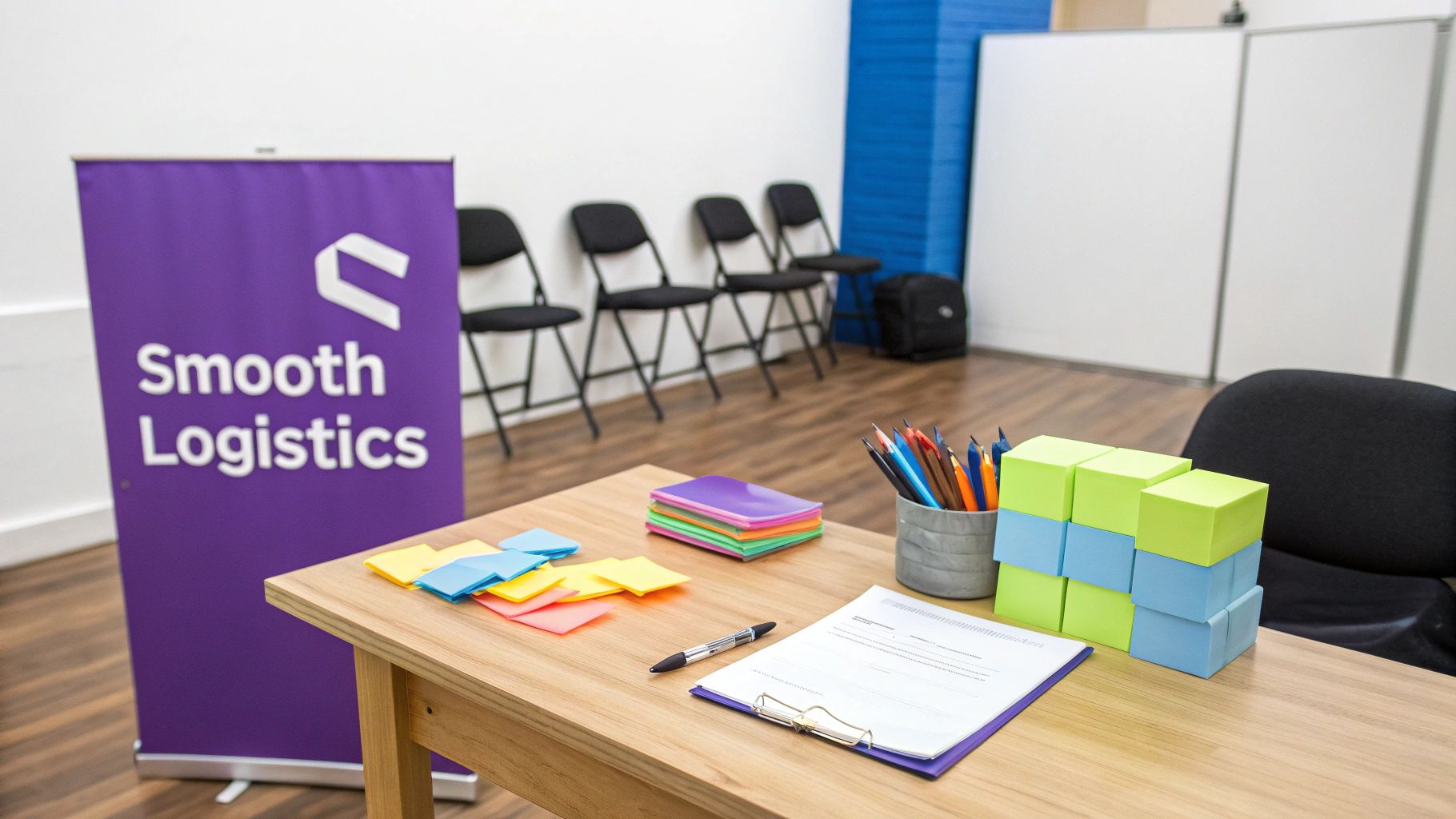
You can have the most brilliant agenda and the perfect group of people, but if the logistics aren't sorted, the whole thing can fall apart. These small details—from a solid Wi-Fi connection to having enough markers that actually work—are the invisible foundation of a great workshop.
Getting the logistics right isn’t just about putting out fires before they start. It’s about creating an atmosphere where people feel comfortable, focused, and ready to dive in. When everything runs smoothly behind the scenes, participants can forget about the mechanics and lose themselves in the creative work.
Setting the Stage for In-Person Success
When you're meeting in person, the physical environment has a massive impact on the group's energy. Think of the room itself as one of your most important facilitation tools.
First off, try to find a space with plenty of natural light and good acoustics. A stuffy, dark room is an energy vampire. Even more critical is the seating arrangement. Forget lecture-style rows; opt for small table clusters or a U-shape so everyone can see each other and feel like part of a single conversation.
Then, you've got to think about supplies. Here's my non-negotiable checklist:
- Writing Surfaces: Make sure you have whiteboards or flip charts that everyone can see.
- Essential Tools: Stock up on sticky notes, sharpies, and dot stickers. Pro tip: I always test the markers beforehand. There's nothing worse than grabbing one mid-flow only to find it's completely dried out.
- Comfort Items: Simple things like having water, coffee, and a few snacks on hand make a huge difference in keeping people engaged, especially during a long day.
Nailing the Tech for Virtual and Hybrid Workshops
When your workshop is online, your focus shifts from the physical room to the digital one. A seamless virtual experience is built on clear communication and tech you can trust.
This is more important than ever. While in-person workshops still account for about 60% of event revenue, virtual sessions are hot on their heels at 35%. And with 70% of event planners convinced that hybrid is the future, being a master of both physical and digital logistics is essential. You can dig into more of this data in this insightful report on event industry trends from Remo.co.
To make sure your remote sessions are a hit:
- Pick Your Platforms Carefully: Choose a video conferencing tool that has solid breakout room functionality—it's a must for small-group work. Pair it with an intuitive digital whiteboard like Miro or Mural.
- Do a Full Tech Rehearsal: A day or two before the workshop, do a complete run-through. Test your screen sharing, practice setting up breakout rooms, and make sure any other tools are working as expected. This is where you catch the gremlins.
- Send Out Crystal-Clear Instructions: Your pre-workshop email needs to be foolproof. Include one-click links to join, simple instructions, and maybe a quick tutorial for the digital tools. This goes a long way in reducing day-of tech stress for your attendees.
The goal is to make the technology fade into the background. For a deeper dive, check out our complete guide on https://www.remotesparks.com/facilitating-remote-workshops/, which is packed with strategies for creating truly engaging online experiences.
My number one rule for virtual workshops: always have a backup plan. What’s your Plan B if the main video platform crashes? Have a secondary link ready to go. What if someone can’t get the digital whiteboard to work? Be ready to capture their ideas yourself in a shared doc.
Building Anticipation with Great Communication
Your communication doesn't start on the day of the workshop; it begins the moment you send the invitation. This is your chance to set the tone, build some excitement, and ensure everyone shows up ready to contribute.
Don't just send one massive, text-heavy email. A simple sequence works much better.
- The Initial Invite (2-3 weeks out): Clearly state the "why"—the main objective and the problem you're coming together to solve. Be specific about who needs to be there.
- The "Get Ready" Email (3-5 days out): This is where you share any pre-reading or light homework. Attach the final agenda and include all the links they'll need.
- The Final Reminder (24 hours out): Send a short and sweet reminder with the essential info: time, location (or link), and a quick recap of the goal.
This steady drumbeat of communication keeps the workshop on everyone's radar and respects their time by giving them exactly what they need to be prepared.
How to Measure Your Workshop's True Impact
So, the workshop is over. The digital whiteboard is full, and everyone seems energized. But did it actually work? The answer isn’t just about whether people had a good time. A workshop’s real success is measured against the concrete goals you set out to achieve from the very beginning.
This is where you connect the dots and prove the value of everyone's time and effort. Without this, even the most engaging session is just a nice memory that doesn't lead to any real change.
Look Beyond Smile Sheets
It’s tempting to rely on generic feedback forms, but they’re often the least helpful. Asking “Did you enjoy the workshop?” gives you a vanity metric, not a real insight. You need to dig deeper to see what actually stuck.
Keep your feedback survey short, sharp, and tied directly to your workshop objectives.
-
Instead of asking: "Was the content useful?"
-
Try asking: "What is one specific action you will take in the next week based on what we discussed today?"
-
Instead of asking: "Did you find the activities engaging?"
-
Try asking: "Which activity gave you the most clarity on our project's next steps, and why?"
Questions like these push people to reflect on tangible takeaways. They give you solid data on whether your key messages were actually understood, not just heard.
Measure Tangible Outcomes and Behavioral Change
The most powerful measure of success is what happens after the workshop ends. Did the session actually change how people work or think? This is where you move from subjective opinions to hard evidence.
Take a look at the "before and after" picture.
- Deliverables: If the goal was a project plan, do you have one now with clear owners and deadlines? More importantly, is anyone actually using it?
- Skill Application: For a training session, are people applying those new skills a week later? What about a month later?
- Decision Velocity: If you were stuck on a decision, is the project finally moving forward? Has the team stopped having the same circular conversation?
The ultimate test of a workshop isn't the ideas generated within it, but the actions taken outside of it. You’re aiming for momentum that outlasts the session itself.
Tracking these changes is how you prove the workshop’s value. If you want to dive deeper into connecting these activities to bigger business results, you can explore how to measure training effectiveness and ROI.
Create a Post-Workshop Action Plan
Momentum is a fragile thing. A great workshop builds a ton of energy and alignment, but that feeling can fade fast without a clear path forward. The key is to lock in the next steps before everyone even signs off.
This action plan isn't a simple meeting summary; it's a shared commitment. I always spend the last 15-20 minutes of a workshop building this out with the group. It absolutely must include three things:
- What Was Decided: Spell out the 2-3 most critical decisions or outputs. No jargon.
- Who Owns What: Every single action item gets one owner. "The team" is not an owner.
- By When: Put a specific, realistic deadline on every task.
Get this action plan sent out to the team within 24 hours. This simple follow-through makes a huge difference in accountability. It transforms your workshop output from a static document into a living guide for the team. This is also essential for justifying future creative sessions; understanding how to measure innovation is what separates a fun brainstorming session from a real business driver.
One last tip: schedule a quick follow-up meeting a week or two out. This check-in ensures the action plan doesn't get buried and keeps everyone on track, turning great ideas into real-world progress.
Answering Your Top Workshop Planning Questions
You’ve got a solid plan, you've outlined your goals, but a few nagging questions always seem to surface right before go-time. It’s completely normal. Think of this as your field guide to handling those last-minute uncertainties that can trip up even seasoned facilitators.
Getting these details right is what separates a good workshop from a great one. Let's dig into the questions I hear most often.
How Long Should a Workshop Be?
Honestly, there’s no single right answer. The perfect workshop length is dictated entirely by your goal. Trying to land on one critical decision? You might only need 90 minutes. Building out a full-year strategic roadmap? That could easily take a full day, maybe even two.
The golden rule is to never pad the time. A short, sharp, and focused session will always beat a long, rambling one. Every single time.
Here are a few benchmarks I use:
- Quick Alignment or a Single Decision: Aim for 90 minutes to 2 hours. It's just enough time to get into the details without energy levels crashing.
- Complex Problem-Solving or Brainstorming: Block out a half-day (around 3-4 hours). This gives you room for both expansive, creative thinking and then narrowing down to concrete ideas.
- Deep Strategic Planning: A full day or a multi-day session is often required. You can't rush this kind of foundational work.
And please, don't forget breaks! My go-to formula is a 10-15 minute break every 75-90 minutes. It keeps people energized and prevents brain-melt.
What's the Ideal Number of People to Invite?
For most workshops, the magic number is somewhere between 8 and 15 participants. This range hits the sweet spot—it’s small enough for everyone to have a real voice but large enough to bring a healthy mix of perspectives to the table.
Dip below eight people, and you might struggle to generate enough diverse ideas. Go above 15 or 20, and you'll find it incredibly difficult to manage the conversation and make sure everyone feels included. It just becomes crowd control at that point.
If you absolutely have to include a larger group, the answer isn't a bigger room. It's more facilitators. Plan on using breakout groups heavily to preserve that small-group dynamic where the real work gets done.
How Do I Handle a Difficult Participant?
Sooner or later, you'll get one. The person who talks over everyone, the one who nitpicks every idea to death, or the one who's clearly just scrolling through their phone. The trick is to handle it quickly and with grace.
Your first line of defense is setting ground rules at the very beginning. Co-creating these rules gives everyone a sense of shared responsibility for the vibe in the room. Then, if someone starts derailing the session, you can gently point back to the rules you all agreed on.
If that doesn't work, here are a few things you can try:
- For the Over-Talker: Jump in with something like, "That's a great point, thank you. To make sure we hear from everyone, I'd love to get a different perspective."
- For the Constant Critic: Acknowledge their point without letting it stop the flow. "That's a valid risk we should definitely keep in mind. Let's add it to the 'parking lot' for now so we don't lose the creative momentum."
- For the Checked-Out One: Draw them back in with a direct, low-stakes question. "Sarah, what are your initial thoughts on this?"
Staying calm and neutral is key. Your job is to protect the space so everyone else can continue to do productive work.
Ready to transform your brainstorming sessions from chaotic meetings into focused, productive powerhouses? Bulby provides the structure and AI-powered guidance to help your remote team generate better ideas, faster. See how our research-backed exercises can unlock your team's full creative potential.
